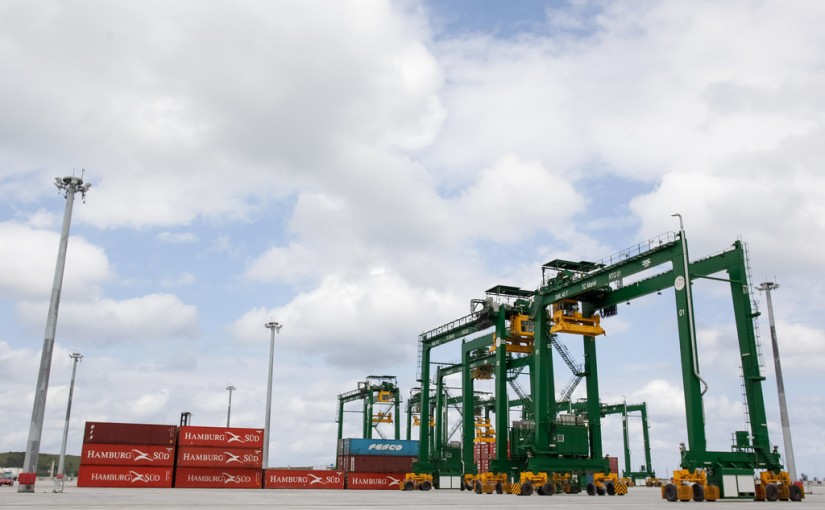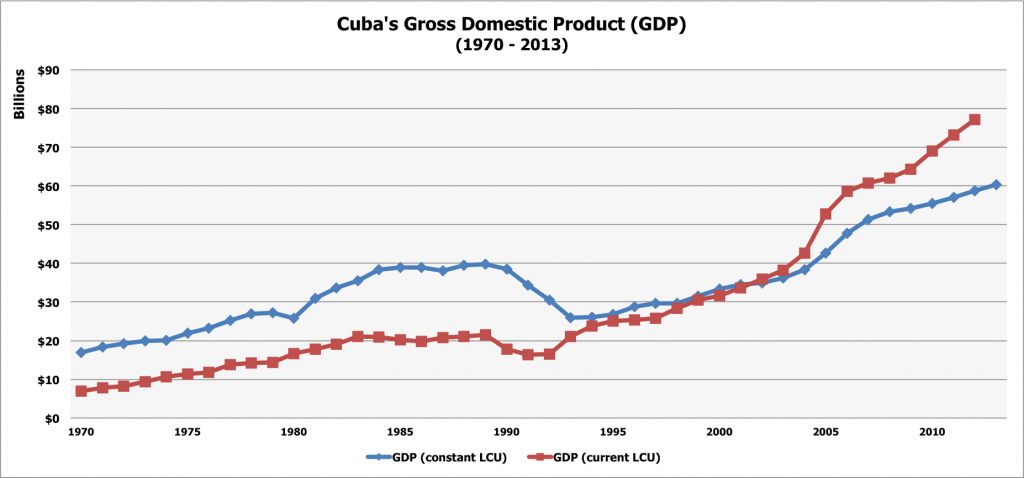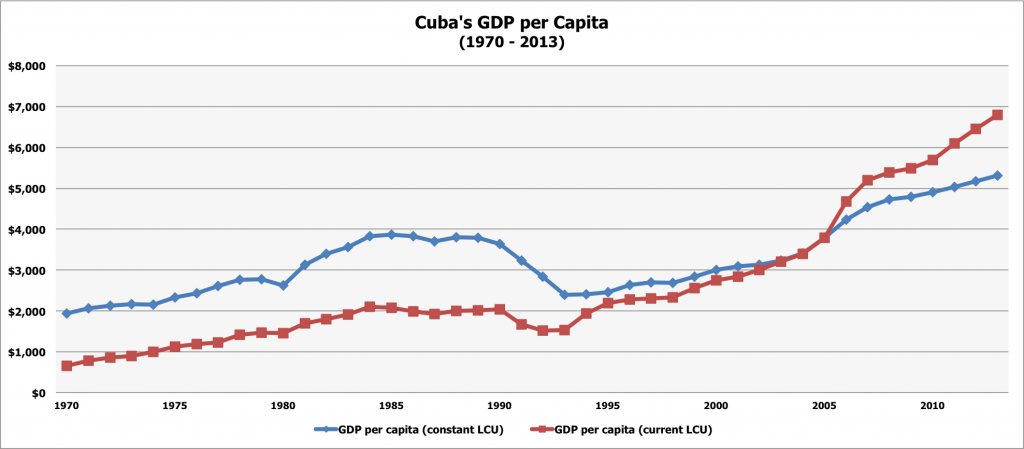Fast Facts (2013 Figures):
Cuba’s current and constant GDP have been steadily increasing:
– 2013 current: $77.2 billion
– 2013 constant: $60.3 billion
GDP Real Growth Rates (Estimates):
– 1.3% (2014)
– 2.7% (2013)
– 3.0% (2012)
GDP primarily driven by household consumption and government spending, which make up 87.6%.
– Household consumption: 55.8%
– Government spending: 31.8%
– Investments: 11.0%
– Exports: 21.2%
– Imports: -19.8%
Overview:
Over the past 40 years Cuba’s GDP has been steadily increasing, even hitting double digit growth in a couple of instances, and reaching almost $80 billion, as of 2013. The two graphs below show the GDP (constant and current), as well as GDP annual growth over the past 40 years. We see that the GDP increases (and decreases) are correlated with the growth rates. The sharp double-digit drop in the early 1990s saw an almost $20 billion decrease in GDP. Since then, GDP growth has rebounded strongly at first and now leveling off in single digits. Although GDP is increasing at a decreasing rate, from 3% in 2012 to 1.3% in 2014, we Cuba’s current GDP figures and recent trends as potentially positive economic growth indicators.
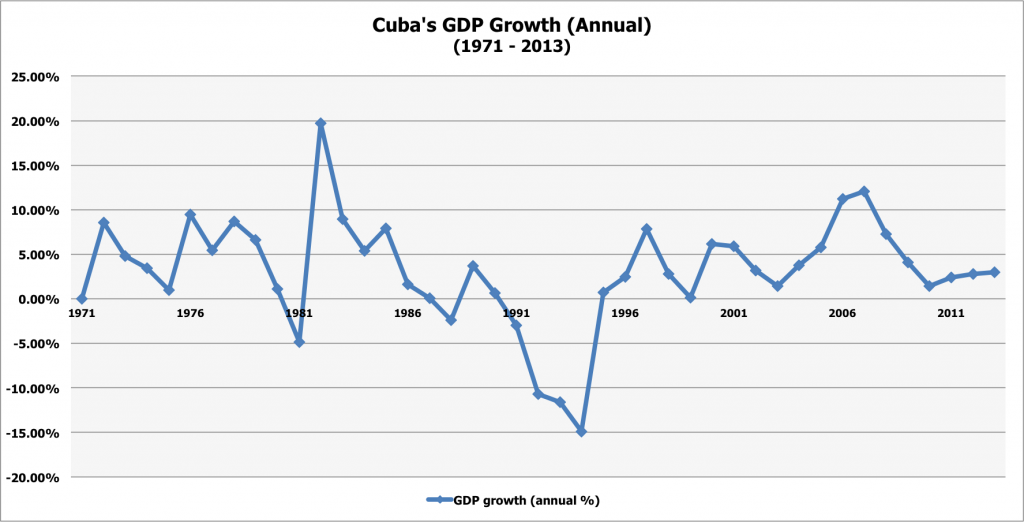
Although we see GDP increasing, the growth rates are actually decreasing, from 3% in 2012 to 1.3% in 2014 (CIA Factbook). Thus, GDP is increasing, but at a decreasing rate. This is in line with what we are seeing in the economy, as the population is decreasing and so is the birth rate, while emigration continues to be an issue. Essentially, there are less people in the labor force to contribute to GDP growth.
GDP Deflator:
GDP deflator tells us the rise in nominal GDP that is attributable to a rise in price rather than in quantities produced. Over the past 50 years, the GDP deflator has been increasing, which means that things cost more now than they did in the past. In 2013, Cuba’s GDP deflator was 128. However, GDP has not grown significantly. There have been some ups and downs in GDP growth over the years, but overall it seems relatively flat and close to 0. The highest growth was in 1981 at almost 20%. Since then it decreased 10 years in a row to -15% in 1993. As of 2013, it was only 2.7%.
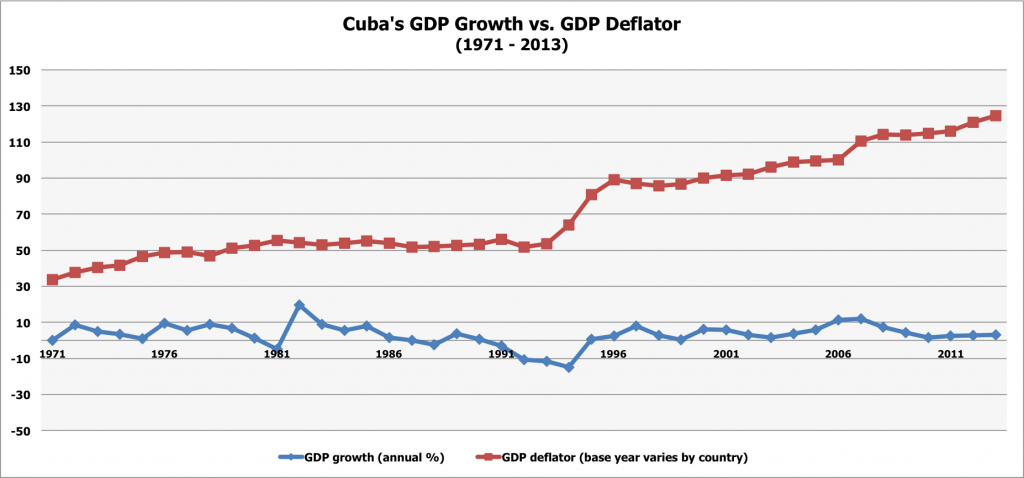
GDP per Capita:
Per capita has been increasing steadily over the past 50 years. Constant per capita GDP was always higher than current per capita GDP until about 2003, when the current per capita GDP began to grow very quickly. In 2003, the current per capita GDP was about 3,200 and more than doubled to about 6,800 by 2013, while the constant only grew to 5,300 in 2013. GDP per capita growth (%) is in line with the GDP growth, peaking in 1981 around 20% and hitting a low in 1993 at -15%. As of 2013, it was at 2.5%.
Cuba’s GDP Components:
By analyzing spending estimates for 2015, we can see which key factors are driving Cuba’s GDP (Y). Household consumption (at 55.8%) and government spending (at 31.8%) are the two largest contributors. Investments (at 11.0%) make a moderate contribution to GDP. Net exports is virtually zero (at 1.4%), because Cuba is essentially exporting the same amount of goods and services that it is importing.
 Cuba’s GDP comes from three primary sectors. The agricultural sector, which includes farming, fishing, and forestry activities, contributes the smallest portion to GDP (approximately 4%). The industrial sector, which consists of mining, energy production, manufacturing and construction, makes the second largest contribution to GDP (at 23.5%). The services sector makes the largest contribution to GDP (at 72.7%), because this sector includes all government activities and private activities that do not produce material goods.
Cuba’s GDP comes from three primary sectors. The agricultural sector, which includes farming, fishing, and forestry activities, contributes the smallest portion to GDP (approximately 4%). The industrial sector, which consists of mining, energy production, manufacturing and construction, makes the second largest contribution to GDP (at 23.5%). The services sector makes the largest contribution to GDP (at 72.7%), because this sector includes all government activities and private activities that do not produce material goods.
Outlook:
Overall, from our perspective as potential investors, we view the GDP trends in Cuba as indicating that there are potential investment opportunities within the country. Despite the currently decreasing GDP growth rate, we think that the economic reforms recently enacted by Raul Castro’s government and improved diplomatic relations with the United States will foster GDP growth.
In the future, we expect to see more entrepreneurship within Cuba, which will grow the private portion of the services sector and increase household spending as self-employed individuals are able to earn (and thus, spend) more money. Per capital GDP has begun to increase since Raul Castro became president in 2008. As diplomatic relations continue to improve with key potential trading partners, we expect to see a flow of foreign investments into the country, which will foster tourism and economic growth. Furthermore, if the U.S. lifts its trade embargo, Cuba’s exports would drastically increase, particularly those of petroleum, tobacco, sugar and coffee. Not only would the U.S. begin trading with Cuba, but so would the U.S. allies.
Sources:
The CIA World Factbook
The World Bank – World Development Indicators
